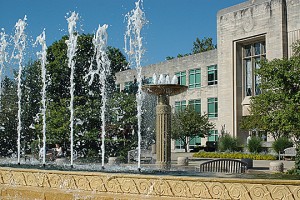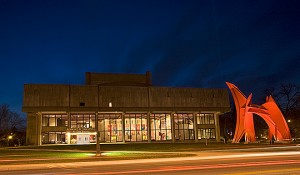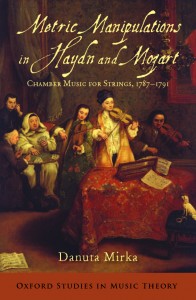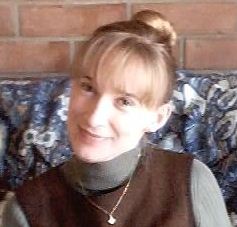Meter in the Midwest
Reader in Music Danuta Mirka has just returned from Indiana, where she was a distinguished guest at one of the largest faculties of music in America:

Last week I stayed in the US, guest lecturing and teaching in the Music Theory Department of the Jacobs School of Music at Indiana University, Bloomington. My previous stay in Bloomington was in 2001-02, when I came as Senior Fulbright Fellow to work on a research project which led to my book Metric Manipulations in Haydn and Mozart: Chamber Music for Strings, 1787–1791. This time I was invited as the Robert Samels Visiting Scholar in Residence.

The Robert Samels Visiting Scholar Program is part of the Five Friends Master Class Series, made possible by the generous support of the Georgina Joshi Foundation. The programme, launched in 2012-13, allows the Music Theory Department to bring three exceptionally well-regarded scholars each year to spend a few days in residence in Bloomington, giving lectures, teaching classes, leading workshops and meeting graduate students. In the inaugural year the visiting scholars in residence were Joseph Straus (CUNY), Janet Schmalfeldt (Tufts), and Peter Schubert (McGill). This year the theory faculty invited Jocelyn Neal (University of North Carolina), Richard Cohn (Yale) and myself. During my three days in Bloomington I delivered a public lecture ‘In Search of the Historical Listener’, gave a research colloquium ‘Harmonic Schemata and Hypermeter’ and taught graduate seminars in the history of music theory and tonal analysis.
 In the lecture I concentrated on my work in the area of rhythm and meter which led me to an understanding of eighteenth-century meter in the light of three factors: metric perception, knowledge of theoretical rules, and familiarity with stylistic implications. I showed how these factors come together in my research and how they open the prospect of reconstructing the historical listener of eighteenth-century music. If the lecture looked back on my earlier achievement, especially, in the Metric Manipulation book, the research colloquium looked into the future and was an opportunity to talk about my current research toward the next book about hypermeter and phrase structure. I focused on the hypermetrical profiles of harmonic schemata, described by Robert Gjerdingen, and demonstrated how they interfere with other factors of hypermetric perception and hypermetrical context. My presentation generated an exciting discussion about perceptual and historical reality of harmonic schemata, their recognition and effect upon hypermeter as they unfold in real time.
In the lecture I concentrated on my work in the area of rhythm and meter which led me to an understanding of eighteenth-century meter in the light of three factors: metric perception, knowledge of theoretical rules, and familiarity with stylistic implications. I showed how these factors come together in my research and how they open the prospect of reconstructing the historical listener of eighteenth-century music. If the lecture looked back on my earlier achievement, especially, in the Metric Manipulation book, the research colloquium looked into the future and was an opportunity to talk about my current research toward the next book about hypermeter and phrase structure. I focused on the hypermetrical profiles of harmonic schemata, described by Robert Gjerdingen, and demonstrated how they interfere with other factors of hypermetric perception and hypermetrical context. My presentation generated an exciting discussion about perceptual and historical reality of harmonic schemata, their recognition and effect upon hypermeter as they unfold in real time.
The seminars gave me a rare opportunity and utmost pleasure of working with a bunch of smart music theory graduates. In the tonal analysis class we sought to understand formal peculiarities of the first movement of Haydn’s last piano sonata Hob. XVI:52 in the light of cross-references between different styles and genres, commonly known as ‘topics’. In the history of theory class we reconstructed two traditions of eighteenth-century metric notation: the old, in which meter was closely related to tempo, affect and genre, and the new, in which it wasn’t. Individual meetings with graduate students allowed me to go beyond eighteenth-century music and learn about their research related to other repertoires.

My numerous activities were punctuated with equally numerous meals, drinks and social gatherings. It was a great pleasure to catch up with colleagues whom I first met 12 years ago and to get to know new colleagues who have joined the faculty since then. For me it was a remarkable experience to visit the place where I embarked upon a new adventure which brought me to where I am today. I thoroughly enjoyed my visit, the warm welcome of the faculty and students, and the sunny weather which added glow to my days in Bloomington.
